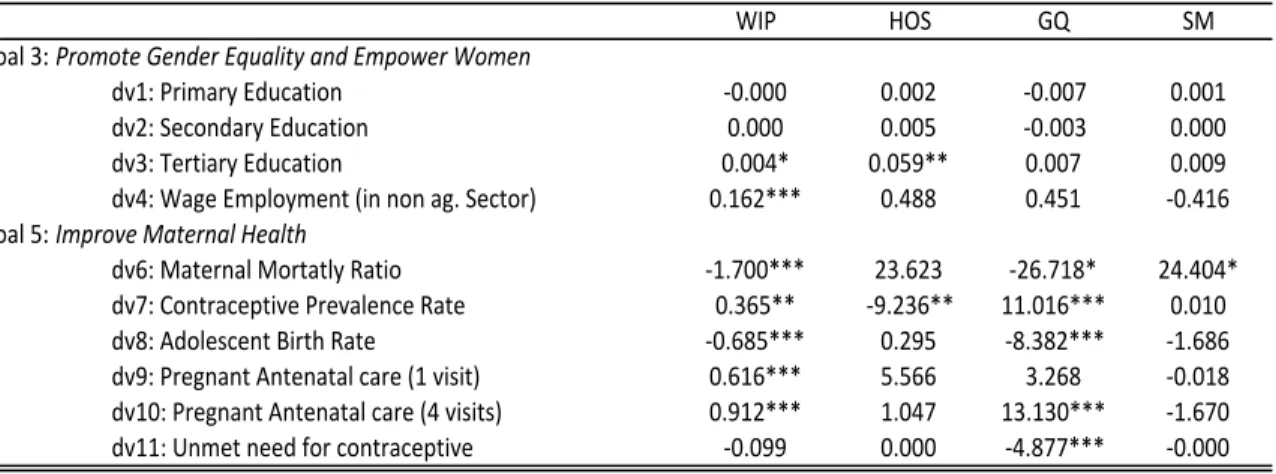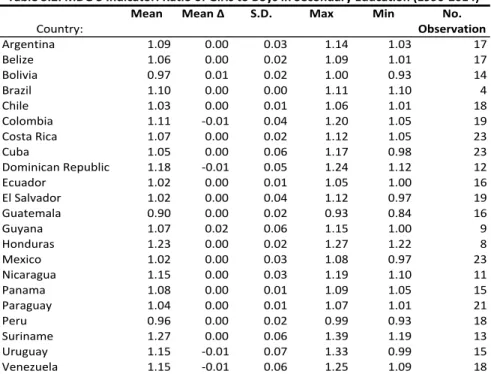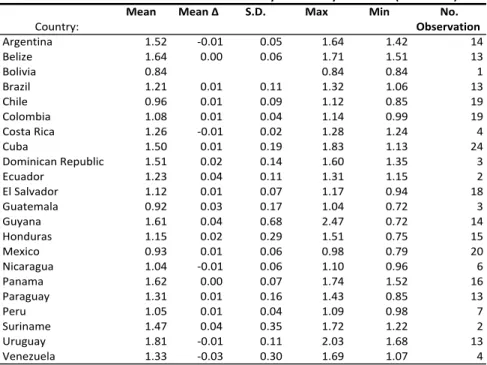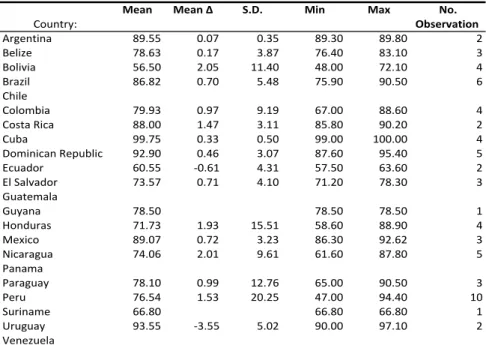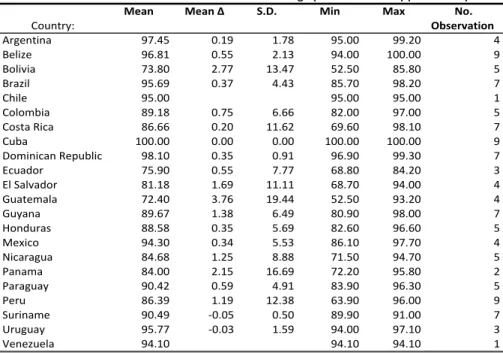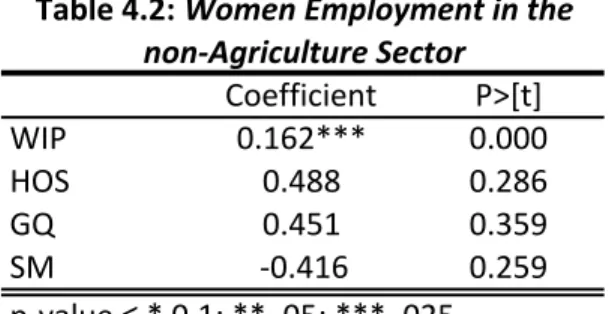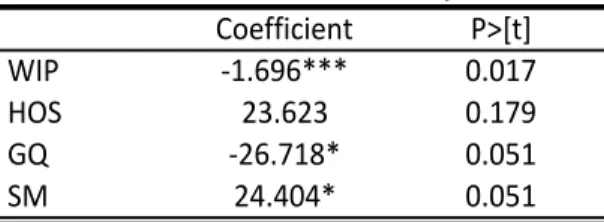I dedicate this thesis to all the women and men who fight for women's rights in the hope of creating a more gender equal society. In the field of women's studies, various debates about women's interests and empowerment have focused on ways to determine what drives women's success and. Is it because women's activism in public settings, such as protests, is higher in some countries than in others.
In this region of contrasts, it is undeniable that women have achieved a greater political presence, as evidenced by the election of these women as heads of state. Women's social movements have proven to be a hallmark for women and change in several Latin American states, especially after the Cold War (Jelin, Zammit and Thomson 9). Because a comprehensive women's movement indicator does not yet exist for Latin America, I construct my own social movement variable that can be applied across time series.
The specifics of these components for this women's movement variable will be discussed in more detail later. In Chapter IV, I present and analyze another dataset that tests variables for women in law and women's movements to determine their effect on MDG 3 and MDG 5 indicators.
Literature Review
When the United Nations came together in 2000 and outlined measurable indicators for the Millennium Development Goals 3 and 5, they then provided a platform for women's interests. By identifying women's interest as an indicator for MDGs 3 and 5, we can begin to better understand and measure women's representation. In an attempt to understand these issues, this thesis focuses on women's representation in the legislature and representation expressed through women's movements.
Considering descriptive representation as a manifestation of Beckwith's 'who', then substantive representation demonstrates 'how' or rather 'how effective' these women in the legislature are in successfully representing women and women's interests. In a study by Barnes and Burchard in 20 African countries they found that as descriptive representation for women increased, so did women's political engagement (784). Her study finds a general consistency across many Latin American countries that women are much more likely to prioritize women's issues.
Given the historical social and political subjugation of women in Latin America, I argue that women in this region are advocates for other women and are critical in promoting women's interests. The prevalence of women's movements in several Latin American countries ensured the involvement of women in the new transitional governments. Others argue that these quotas reduce the actual and perceived effectiveness of women as political actors (Goetz and Hassim 2003; Rinker 2006), that they reinforce rather than challenge the status quo (Htun 2002; Meier 2000), and that they impose a ceiling on women's participation. in the legislature (Zetteberg 718).
Generally, these quotas are adopted by male-dominated legislatures as a result of women's groups inside and outside the parties (Htun and Jones 2002; Lokar 2003; Tripp, Konate, and Lowe-Morna 2006). This is important because the question of who advocates and through which venues for these gender quotas is relevant to the broader understanding of women's movements and representation. The latter approach determines that political, local and historically conditioned processes are responsible for the formation and articulation of women's interests and mobilization (Ray and Korteweg 53).
In addition to issues with identity politics, others questioned whether, after the democratization of Latin America, these women's movements would find a need and. In considering this question, it is important to create a broader understanding of the potential and scope of women's movements. Laura Weldon and Maura Bahu, assert that women's movements influence policy agendas, change public opinion, and raise awareness (Weldon, Protest Makes Policy 129).
I expect to find a positive correlation with meeting MDGs 3 and 5 in countries where women's movement presence is strong and autonomous. This thesis uses MDGs 3 and 5 as a working definition for women's interests and uses their indicators as a benchmark.
Research Design
The first indicator for this MDG is the ratio of girls to boys in primary, secondary and tertiary education. The source for this data is taken from the World Bank Databank citing the International Labor Organization (ILO), Key Indicators of the Labor Market Database as their source for the data. However, the Dominican Republic, Ecuador, Guatemala and Peru have the largest average change for this indicator.
With this indicator, it is also important to pay attention to those countries with the highest average change and the highest mean value. The UN defines the first indicator, MMR, as:. the ratio between the number of maternal deaths in a given time period per 100,000 live births in the same time period. The source of this data is the World Bank data bank, which draws its data from WHO, UNICEF, UNFPA and the United Nations Population Division.
To account for this explicit target, an extra column is added at the end of the descriptive statistics table for this indicator. To measure relative success for this indicator, countries with the highest percentage indicate greater numbers of births attended by skilled health personnel. The countries that have the most consistent and highest percentages for this indicator are indicated by the average.
The data for this indicator was obtained through the World Bank, which cited their sources of information as follows: UNICEF's State of the World's Children and Childinfo, United Nations Population Division's World Contraceptive Use, household surveys including demographic and health surveys, and Multiple Indicator Cluster Surveys. As mentioned earlier, relative success for this indicator is represented by a higher percentage for that country. In addition to Argentina, the countries Brazil, Colombia, Costa Rica, Cuba, Peru and Paraguay have the highest average percentage for this indicator.
The data for this indicator was taken from the World Bank data bank, citing the United Nations Population Division, World Population Prospects as their source. As previously mentioned, relative success for this indicator is represented by lower and decreasing rates throughout the time series. The data for this indicator comes from the World Bank, which cites UNICEF, State of the World's Children, Childinfo and.
The calculation method for this indicator is the percentage of women of reproductive age who. The World Bank, which cites household surveys, including Demographic and Health Surveys and Multiple Indicator Cluster Surveys, provides data on this.
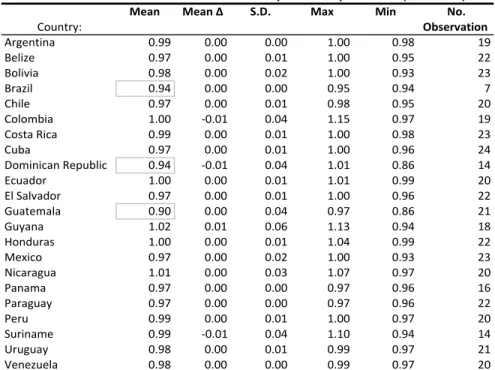
Women’s Movement and Women in Legislature Variable Analysis
Currently, no comprehensive women's social movement variable has been developed for the countries of Latin America. For the social movement variable, I draw on several sources to monitor women's protest activities in a given country at a given time. The first, “reconstitución del movimiento de mujeres”, follows a reconstruction of the women's movement of 1975-1995 for the above-mentioned countries.
This social participation focuses on the formation of women's unions and their participation in strikes and protests. The remaining information for the social movement variable comes from an overview of newspaper headlines and articles that mention women's protests in the Latin American countries. In this data section, women in parliament (WIP), women heads of state (HOS), gender quotas (GQ) and women's social movements (SM) are the independent variables.
It is interesting to note that the only statistically significant correlation for the women's social movement variable is for maternal mortality. The recognition that “women in the legislature” has a statistically significant effect on this important indicator potentially speaks to the discourse surrounding the effectiveness of the legislature in expressing women's interests. In this case, the data support the idea that a greater presence of women in the legislature is positively correlated with women's employment in the nonfarm sector.
Shown in the following table, the significant variables for this indicator are women in parliament, gender quotas and women's social movement. This is the only case where the women's social movement variable has a significant effect on an MDG indicator. This suggests that these two variables are important in advancing women's interests, and further demonstrates the effectiveness of the legislature as a venue for advancing women's interests.
In this thesis, I tried to find out what effect, if any, women in the legislature and women's social movements have in promoting women's interests in Latin America. Surprisingly, the indicator of women's movement did not have much impact on the dependent variables. Regardless, however, this negative impact of the women's movement indicator on the maternal mortality ratio may point to a broader discussion arguing that the presence of the women's movement diminishes women in the political process by making it ineffective.
Instead, it is more likely, based on this analysis, that the presence of women's movements is negligent for Latin American countries' success of MDG 3 and 5 over this time series. To understand the influence of the women in the parliament variable and a study of these specific countries will hopefully shed more light on what other factors are important and relevant to promote women's involvement in the legislature and promote women's interests .
